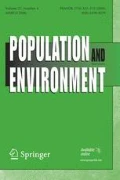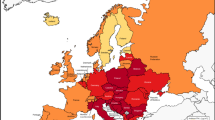Abstract
A robust, globally implementable and simple empirical model to predict the arsenic pollution affected life expectancy using a stepwise regression was developed. Life expectancy calculated using a life table technique requires crude death rates data that are not available for small administrative units, complex calculations and does not consider socioeconomic parameters. Hence, a model was needed to forecast the impact of arsenic pollution and socioeconomic parameters on life expectancy for locations with limited data availability. A linear multiple regression technique was used to develop an empirical model to predict arsenic pollution affected life expectancy at birth. The model was calibrated using nine arsenic polluted administrative blocks of district Murshidabad, West Bengal, India and tested independently for three other arsenic polluted blocks of the same district. The R 2 values for the plot of actual versus predicted life expectancy at birth were 0.98 for calibration, testing and independent validation. The model is complementary to the life table technique and offers a means to assist planning by public health engineers and health policy makers to mitigate arsenic pollution on a community priority basis.





Similar content being viewed by others
References
Abernathy, C. O., Calderon, R. L., & Chappell, W. R. (1997). Arsenic exposure and health effects. London: Chapman and Hall Press.
Brown, K. G., Boyle, K. E., Chen, C. W., & Gibb, H. J. (1989). A dose–response analysis of skin cancer from inorganic arsenic in drinking water. Risk Analysis, 9, 519–528.
Central Ground Water Board. (1999). High incidence of arsenic in groundwater in West Bengal: Central Groundwater Board. New Delhi: Ministry of Water Resources, Government of India.
Chen, C. J., Kuo, T. L., & Wu, M. M. (1988). Arsenic and cancers (letter). Lancet, 1, 414–415.
Crimmins, E. M., Saito, Y., & Ingegneri, D. (1997). Trends in disability-free life expectancy in the United States, 1970–1990. Populant Development Review, 23, 555–572.
Das, N. G. (2000). Statistical methods in commerce, accountancy and economics. Kolkata: Manasi Press.
Elandt-Johnson, R. C., & Johnson, N. L. (1980). Survival methods and data analysis. New York: Wiley.
Gaus, I., Webster, R., & Kinniburgh, D. G. (2001). Scales of variation. In Kinniburgh, D. G., Smedley, P. L. (eds.) British Geological Survey Technical Report WC/00/19: Keyworth, pp 161–173.
Lai, D. J., Lee, L. M., & Lee, E. S. (2000). Effects of handicap on life expectancy: The case of China. Public Health, 114, 330–335.
Landau, S., & Everitt, B. S. (2004). A handbook of statistical analyses using SPSS. Washington, DC: Chapman and Hall/CRC Press, LLC.
McCuen, R. H., & Snyder, W. M. (1986). Hydrologic modeling: statistical methods and applications. New Jersey: Prentice-Hall.
Mutafova, M., van de Water, H. P. A., Perenboom, R. J. M., Boshuizen, H. C., & Maleshkov, C. (1997). Health expectancy calculations: a novel approach to studying population health in Bulgaria. Bulletin of the World Health Organization, 75, 147–153.
National Research Council (NRC). (Oct. 5, 2004). Arsenic in drinking water. http://www.nap.edu/ 1999.
Newell, C. (1988). Methods and models in demography. New York: The Guildford Press.
Nusselder, W. J., van de Velden, K., van Sonsbeek, J. L. A., Lenior, M. E., & van den Bos, G. A. M. (1996). The elimination of selected chronic diseases in a population: The compression and expansion of morbidity. American Journal of Public Health, 86, 187–194.
Rogers, A., Rogers, R. G., & Belander, A. (1990). Longer life but worse health? Measurement and dynamics. The Gerontologist, 30, 640–647.
Rogers, A., Rogers, R. G., & Branch, L. G. (1989). A multistate analysis of active life expectancy. Public Health Reports, 104, 222–226.
Samadder, S. R. (2005). Assessment of risk due to arsenic pollution in drinking water in West Bengal: A GIS approach. PhD thesis 2005. Department of Civil Engineering: Indian Institute of Technology Kharagpur, India.
Samadder, S. R. (2010). Impact of arsenic pollution in drinking water on life expectancy: A GIS approach. KSCE Journal of Civil Engineering, 14, 681–691.
Samadder, S. R., & Subbarao, C. (2007). GIS approach of delineation and risk assessment of areas affected by arsenic pollution in drinking water. Journal of Environment Engineering, 133, 742–749.
Smith, A. H., Hopenhayn-rich, C., Bates, M. N., Goeden, H. M., Hertz-Picciotto, I., Duggan, H. M., et al. (1992). Cancer risks from arsenic in drinking water. Environmental Health Perspectives, 97, 259–267.
Smith, A. H., Lingas, E. O., & Rahman, M. (2000). Contamination of drinking water by arsenic in Bangladesh: A public health emergency. Bulletin of the World Health Organization, 78, 1093–1103.
Tseng, W. P., Chu, H. M., How, S. W., Fong, J. M., Lin, C. S., & Yeh, S. (1968). Prevalence of skin cancer in an endemic area of chronic arsenicism in Taiwan. Journal of the National Cancer Institute, 40, 453–463.
Valkonen, T., Sihvonen, A. P., & Lahelma, E. (1997). Health expectancy by level of education in Finland. Social Science & Medicine, 44, 801–808.
Welch, A. H., & Stollenwerk, K. G. (2003). Arsenic in groundwater. Boston: Kluwer Academic Publishers.
Wong, K. M., Strecker, E. W., & Stenstrom, M. K. (1997). GIS to estimate storm–water pollutant mass loadings. Journal of Environment Engineering, 123, 737–745.
World Health Organization (WHO). (1984) Guidelines for drinking water quality. Geneva 1: 53.
Wu, M. M., Kuo, T. L., Hwang, Y. H., & Chen, C. J. (1989). Dose–response relation between arsenic well water and mortality from cancer. American Journal of Epidemiology, 130, 1123–1132.
Acknowledgments
The authors acknowledge the support of Public Health Engineering Department (PHED) Murshidabad; District Land and Land Reforms Office (DL & LRO) Murshidabad; and Census of India, Directorate of Census Operations West Bengal for providing the relevant data required for the present research work. The authors appreciate Mr. Goutam Roychowdhury, Executive Engineer, Public Health Engineering Department (PHED) Murshidabad for providing the arsenic distribution data of the study area.
Author information
Authors and Affiliations
Corresponding author
Rights and permissions
About this article
Cite this article
Samadder, S.R., Nagesh Kumar, D. & Holden, N.M. An empirical model to predict arsenic pollution affected life expectancy. Popul Environ 36, 219–233 (2014). https://doi.org/10.1007/s11111-014-0212-5
Published:
Issue Date:
DOI: https://doi.org/10.1007/s11111-014-0212-5




